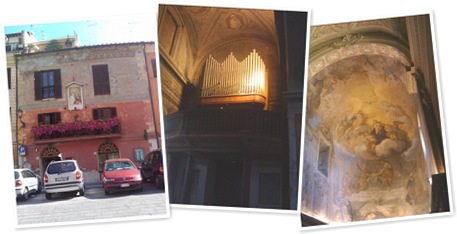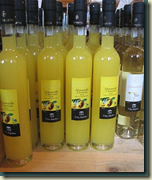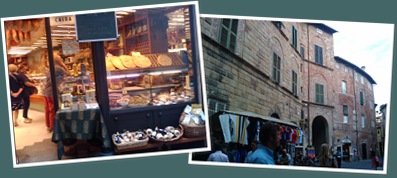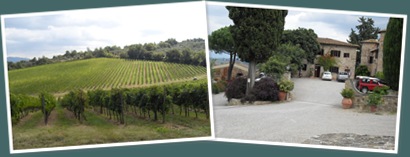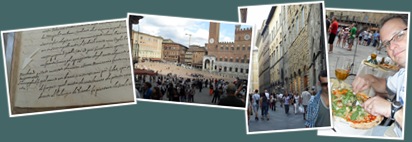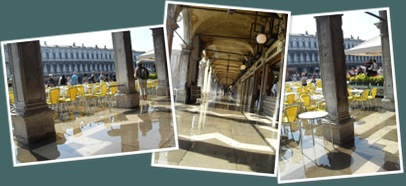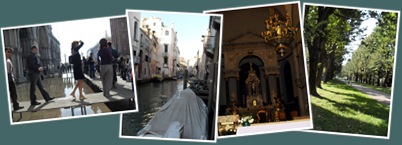 Finally, we went to Italy. There were 14 wonderful days in a delayed celebration of our 20 years of marriage. But we did not like many people who pay a packet to the main tourist cities of a country. Ours was more romantic without the obligation of visiting exciting places and postcards.
Finally, we went to Italy. There were 14 wonderful days in a delayed celebration of our 20 years of marriage. But we did not like many people who pay a packet to the main tourist cities of a country. Ours was more romantic without the obligation of visiting exciting places and postcards.
The first thing we did was define where to stay and enjoy the days. Of course we have had the usual help from our friend Lelia, the  Mundo Afora Viagens, to set the path, buy cheap tickets, book hotels, hire car, hire insurance and get the international drive license. Moreover, in all situations where we need help, she was always present and answered text messages on mobile.
Mundo Afora Viagens, to set the path, buy cheap tickets, book hotels, hire car, hire insurance and get the international drive license. Moreover, in all situations where we need help, she was always present and answered text messages on mobile.
Alitalia was not a good choice of airline. Both on the trip, and in return, our seats reclined not right. Control equipment for video and sound are very bad and slow to respond to commands. Likewise, the inflight service is bad and the flight attendants are arrogant. I do not consider myself patriotic and I speak English, but I find it absurd that a flight leaving from Brazil to Italy (and vice versa) the crew only speak in Italian or English. And do not even try to understand us in Portuguese. I have traveled to Europe by TAM and both airplane and crew are excellent.
As we wanted to walk through Tuscany and know its charms, we decided to host first in Firenze (Florence), its capital. That is because Florence is at the heart of Tuscany and everything we would like to see was within a range of up to 100 km. We rented a car that we got in Rome airport on the day we arrived. And here are the first tips:
** If you rent a car in Europe, have a basic car. By the basic category, we've got a Renault Clio that has nothing to do with the brazilian. They are far superior and better equipped than ours.
** Do not forget to get the international drive license. It takes 10-15 days to arrive and it’s the first thing they ask for when you pick up the car.
** Take an updated map with GPS. Even small roads of land were registered and had no problem finding the paths. It made all the difference ...
** The A1 motorway has a speed limit of 130 km/h, but if you stay left of the track will be hit by Audi, BMW, Porsche, Ferrari who reach easy at least 180 km / h.
** Study the map of Italy by Google Maps (www.maps.google.com). Even with GPS, it's good to know which way is going and how close to your destination is another town that is worth while to visit.
We arrived at Rome, but soon took the road from the airport to Florence. They say that Rome has chaotic traffic and we decided not to face it that day. We would come back by train, which did not happen ...
As we were tired because of the 11 flight hours and the 5 hours time-zone (5h in Italy with regard to Brazil) we decided to reach the highway and just rest a little. But along the way, I (Fabiana slept) saw a small city at top of a hill off the road and I decided to go there. So we were delighted that we know the first small medieval city in Tuscany: Magliano Sabina. Not on the list of our target cities, but we started being enchanted by the medieval architecture and the care that residents have with the cleanliness and the flowers in the eaves of the windows and doors. Very common in Italy, I photographed (below) a house with the picture of Mary with Jesus. Unpretentiously, we entered into a church. There was nobody there and we could enjoy the beauty of the paintings on the ceiling and pipe organ, I would like to have heard it played.
So we walked for about one hour in Magliano Sabina and continued the trip to Florence.
In Florence, we stayed at Florence Anglo American Hotel, a 4 star hotel near the downtown and major tourist attractions. Although it is not our goal be visiting museums and tourist icons, we walked a lot once they say Firenze is an open art gallery. In fact, Tuscany is all an open work of art.
Especially, I point out the Galleria degli Uffizi for those who love Renaissance art. There are a lot of paintings and sculptures from various artists like Michelangelo, Leonardo Davinci and Caravaggio.
*** Hot Tip: Buy tickets online, because the entrance queue for those who already bought is much smaller. If you decide to buy at the front desk separate at least 1 hour and a half of your day to spend in the queue. But look at the picture below and understand why to go.

The Galleria is close to Piazza della Signoria, where is the Palazzo Vecchio, Santa Croce church and the Fontana del Nettuno. The number of statues in this square and the quality of the work is impressive. I was fascinated with the details of the statue's feet that looks alive (picture below). It's worth checking out.
In the streets around this square, there are a multitude of shops to buy souvenirs. There are shops for all tastes and pockets: from trinkets to such stores as Ferrari, Louis Vuitton and Prada. 300 meters away, is the Piazza del Duomo, where you can visit the Duomo Cattedrale di Santa Maria del Fiore. But go prepared because there are more than 400 steps to reach the view from the top (picture below). If you have claustrophobia, do not venture, because the way is long, narrow and crowded up and down. At some points of the climb the congestion of people did not let us go forward in a place totally muffled.
I indicate, in particular, two restaurants for dinner in Florence:
One is La Grotta Ristorante Guelfa, which is on via Pellicceria, 5R, near Piazza della Signorina. Try a table on the outside of the restaurant. There is bier (birra), various wines and if you want to try, the wine of the house is very good. On the first page of the menu, there is option to choose one of the packages prepared for tourists who have interesting prices and are well served, including wine.
The other restaurant is very charming Trattoria La Carabaccia, built in an old tavern of the seventeenth century and which remains to this day, the same brick arches that time. 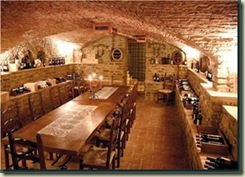 Downstairs there is a small cellar with tables and chairs that I could not describe properly, but you can see in the picture.
Downstairs there is a small cellar with tables and chairs that I could not describe properly, but you can see in the picture.
Carabaccia was a boat-shaped nutshell, carrying sand and salt by the Arno, the river that cross through all Fizenze. It is also the name of a soup recipe, found in the menu of many local restaurants. But what matters is that the food is excellent. I ate as the secondo piatto the famous Fiorentine sliced steak that it melted in the mouth.
The Italians have a habit of serving a full meal consisting of input, the first dish, the second dish and dessert. The entrance, or as we know, antipasto, has options like beef or tuna carpaccio, raw ham with melon or some cream, our known bruschetta, crostini and some kind of salad. The first plate (primo piatto) is basically mass-type spaghetti, tagliatelle, fettuccine, farfalle, etc.. The second course (secondo piatto) is beef, fish, rabbit, lamb, chicken, pork. Some restaurants offer several choices of meats and others, simpler, usually just beef and pork.
*** HOT TIP: Be sure to ask, as "digestive" the famous limoncello, a lemon liqueur served cold. Don’t miss that.
Well, once in Florence, we made a basic guide to visit the main cities within a range of up to 70 km which we had planned to go. West of Florence, we went to Lucca, Pisa and Vinci, the town where Leonardo da Vinci was born.
Lucca is another of those medieval towns in Tuscany you must meet. Walking through the streets, whose width does not fit two cars side by side, with calm and paying attention to details is refreshing. By the way, we use to walk a lot without perceiving because on the way all the time we stop for a snack, an ice cream or a birra (Italian beer) at one of the many trattorias that are out there. We always find something different, unusual, and spend hours admiring the scenario. And beautiful landscapes are what they have the most.
The first record of Lucca was made by Livio mentioned that as part of the Roman Republic at least since 218 BC, where it appeared in 180 BC as a Roman colony, and as municipium in 90-89 BC.
The historic center of Lucca project preserves the Roman street plan and the Piazza San Michele occupies the site of an ancient forum. Remains of an amphitheater can still be seen in Piazza dell'Anfiteatro. Lucca was the conference that took place in 56 BC that reaffirmed the superiority of Roman First Triumvirate.
Pisa is controversial. Some people say there is nothing to see but the Pisa Tower famous for being tilted. But I (and Fabiana also shares this point of view) loved the square where is placed the tower of Pisa. It is very beautiful and intriguing. The tower is a sideshow, the more because of the beauty and the architectural details carved in white marble than because it is tilted. But the composition of the buildings constructed at that location with an open lawn where they all lie down to enjoy the scenario is that it gives a sense of peace that only those who have no sensitivity to say they didn’t like Pisa.
Vinci is the town where Leonardo da Vinci was born. One of the greatest painters of the Renaissance, and possibly its greatest genius, as it was also an anatomist, engineer, mathematician, musician, naturalist and philosopher, and architect, sculptor and reinvented Italy tales. In fact, the house he was born is 3 km far from the downtown, but the name of the genius was given because of the city (Leonardo di Ser Piero da Vinci - Leonardo, son of Piero, from Vinci). Obviously there is a museum about him there. But there are no paintings of him in that place, but a lot of devices, methods, and machines that he built and used to understand the geometry of the figures, the effects of light and shadow and perspectives. Only by studying a little of what is shown there to understand his genius. Before drawing and painting, he understood all the science behind that image. It's incredible.
Moreover, once again, the landscape outside the city walls is wonderful. If you climb the tower of the museum, you can see the entire region.
South of Florence, we visited the valley of the famous Chianti wine, Greve in Chianti. It is also a beautiful region by large vineyards and olives.
Further to the south, we also visited cities like Siena, San Gimignano, Pienza.
Siena is universally known for its artistic heritage, and the remarkable stylistic unity of its historic center, a UNESCO World Heritage Site. According to Roman mythology, Siena was founded by Senio, the son of Remo, and we can find numerous statues and works of art showing, as in Rome, the brothers breastfed by the wolf. It was an Etruscan settlement and later Roman colony (Saena Julia) rebuilt by Emperor Augustus. It was, however, a small town, away from the main routes of the Empire. In the fifth century, it becomes the seat of a Christian diocese. The main square, shaped like a crescent moon, is the Piazza del Campo, and is placed to the Palazzo Pubblico (town hall or city hall, fourteenth century), with the famous Campanile (bell tower), and where we find the Simone Martini and Ambrogio Lorenzetti paintings and the Fuente Gaia of Jacopo della Quercia. In this square is also located the high Torre del Mangia. In the Piazza del Campo happens the famous horse race called Palio di Siena. The Palio is done twice a year, on July 2 and August 16, with 10 horses and riders, and each pair represents one of the 17 districts of the city, designated contradicted. Exceptionally, in the Jubilee year there will be a third Palio.
It pays to visit the Library Comunale degli Intronati. There are handwritten records (below) the battles between Siena and nearby towns in the XII and XIII centuries written by their own commanders.
Oh, be sure to take a gelato (ice cream) ... Italian is very good.
San Gimignano was a separate chapter of our trip. Town of 7,105 inhabitants with a special charm, was founded in the tenth century on top of a hill in the Val D'Elsa (Colle di Val D'Elsa) by the Etruscans. Beyond the streets and terraced houses of medieval stones, was where we saw more paintings and symbols of that age (pictures). But the most remarkable happened when we went into a kind of courtyard, an alley houses too flowery and arranged with perfect acoustics and a man playing Ave Maria (Schubert) on flute. Although he was there to collect a few pennies from the most generous tourists, no one can hold the emotion in a place like that and listening to Schubert ...
Pienza is an unique town. It has been often defined as the "utopian city" or the "ideal city". That's because it was a totally planned city in the Renaissance. Pius II wanted a retreat outside of Rome and decided to completely rebuild his home village. It eventually became a landmark of urban design. Pienza is so lovely it made us leave Fizenze one day ahead of schedule. After walking through the streets, and once again we were delighted with the medieval houses adorned with plants and flowers we found in a magical place called Antica Locanda host, directed by Barbara. But the person that attended us was her mother, the gentle Daniela, a woman who does not speak English or Portuguese, but had good will and patience to try to understand my poor Italian. Thus, we return to Florence, we slept one more night and we did the checkout in the morning to stay in an apartment with a wonderful view over the Val d'Orcia.
10 km from Pienza, we found Montepulciano, whose the particularity was to find the winery Gattavecchi whose owner is the sympathetic Italian Gionata and his brasilian wife Lilian from bahia. We were greeted by Gionata, who speaks Portuguese, and his son. Therefore, we also had the company of George, brother of Lilian, whose accent is an unmistakable Bahiano. He plays and sings for tourists groups who hire Lilian to cook a mixture of Tuscan with spiced Bahiana cuisines. We visited the underground chamber where are the oak barrels for aging wine. Very common in these locations, we were introduced to an Etruscan tomb at the end of a long, cold, wet stairs. It's worth to go there and to meet them.
The highlight of the trip: in Sant'Angelo in Colle, we stayed at a winery, which offers service called agritour. It's called Posta di l'Orciaia Argiano (WARNING: if you stay there and try to find the place by the name Hotel Argiano, will not find. You have to say the correct name). There are 3 huge and very charming apartments. Each apartment has one of the wines name produced by azienda: Rosso di Montalcino with two suites, the Lolengo with four suites, the Suolo with 5 suites. All are composed of rooms with bath, large living room with LCD TV, stereo and DVD and dining table, fireplace and full kitchen set up. From the bedroom window, we could admire the architecture of a small church built in the sixteenth century. Walking to the end of the garden which is in the opposite of the apartment stairs, we got a pass to the swimming pool very well attuned to the corridor of trees, plants and flowers. 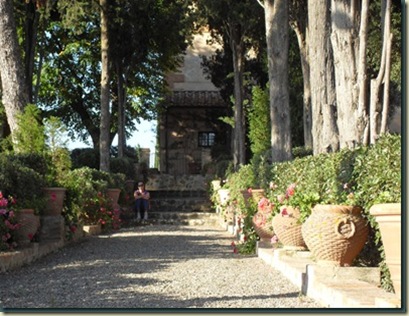
The morning after our arrival, we made a tour to learn about the process of making wine. Another couple, tourists from California, USA, had booked a winery visiting and we join them. The guide told us all the steps and facilities to produce wines Argiano, including the famous Brunello di Montalcino. She showed us where the wines are stored for maturity, an underground chamber excavated to serve as an Etruscan tomb. The photo below is of a group of wine kept under lock inside one of the tombs, whose production dates back to 1970. We can see the black fungus that formed during this whole time saved. Imagine the value of each bottle...
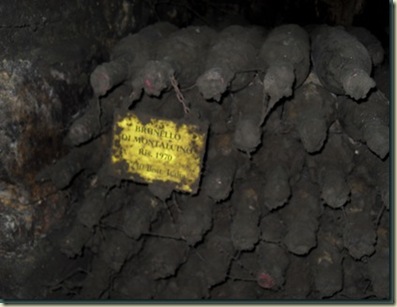
As in most of Tuscany azienda, they also produce olive oil. Moreover, the building where the apartments are located used to be a warehouse where the oil was produced, called "Orciaia" in Italian. Therefore, the site is named Posta di l'Orciaia Argiano.
This place is fantastic. Movie stuff. You’ve got to see to believe it. There are buildings that date back to 1582 with walls two feet wide inlaid in a field of grapevines and olive trees. Not exactly a hotel, so there is no room service at night. Most employees work in the winery during the day and there is a maid who does the cleaning, towels and linen exchange and serves the coffee table in the apartment at 8:00 am. But after 6:00pm there is not a soul in the place but the guests. As we were the only ones in those days, we were alone in paradise. I lit the fireplace and cooked a risotto with black truffle we bought in a trattoria in Montalcino and opened a rosé wine ...
After two nights in that wonderful place, we traveled to Venice, which they say is one of the most romantic city in the world. After Tuscany, it was difficult to agree with that, but we still had a good time there.
The first big hint that I take: there is no car in Venice. So if you drive you must leave the car out of town. It has a large parking called Tronchetto, which you find taking the right way of the bridge Ponte della Libertà that connects Venice to the mainland and costs 21 euros a day. From there, you pick up a vaporetto, which is a public transport service for boats that travel in large canal. In 12 minutes we were at our destination.
We stayed at the Hotel Gabrielli in front of the great channel through which we see over the huge cruise ships arriving in Venice. It is located 500 meters from the famous Piazza di San Marco.
In fact, after passing through Tuscany, the first impression is that Venice is a great fair. We used to visit villages with few inhabitants and some tourists, but nothing compared to what we saw in Venice.  The picture besides is of walking off the Grand Canal. There are many stands of street vendors, Nigerians selling fake handbags of Louis Vuitton and Prada and Indians selling those toys that fly. Madness! Besides, hotels and restaurants in this region has an aspect of old stuff. The buildings are coated with black soot and no maintenance or the care we’ve seen in other cities.
The picture besides is of walking off the Grand Canal. There are many stands of street vendors, Nigerians selling fake handbags of Louis Vuitton and Prada and Indians selling those toys that fly. Madness! Besides, hotels and restaurants in this region has an aspect of old stuff. The buildings are coated with black soot and no maintenance or the care we’ve seen in other cities.
But some things did Venice being also a good memory of that trip.
The first thing that we dropped was the belief that the city stinks. LIES. T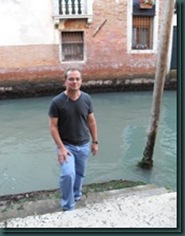 here is nothing to do with that. The smell is normal like a city by the sea. It is a fact that there are alleys that has a strong smell of urine as in any big city. But do not generalize. When we started to walk through alleys and canals of seawater, a romantic aura, magic because his own condition of being inside the water surrounds us. This photo shows the end of a lane that ends in a ladder of narrow channels that cross the city. To cross the other side, you must find one of the bri
here is nothing to do with that. The smell is normal like a city by the sea. It is a fact that there are alleys that has a strong smell of urine as in any big city. But do not generalize. When we started to walk through alleys and canals of seawater, a romantic aura, magic because his own condition of being inside the water surrounds us. This photo shows the end of a lane that ends in a ladder of narrow channels that cross the city. To cross the other side, you must find one of the bri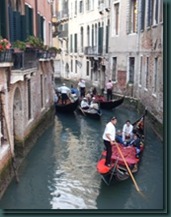 dges that give access. It is very beautiful and intriguing.
dges that give access. It is very beautiful and intriguing.
Walking to the southeastern of the island, we found a great park, the Giardini Pubblici (Public Gardens) and behind ordinary houses of the Italian residents of the city. It's a part very peaceful and pleasant place to visit.
Piazza di San Marco, where the basilica is located is a huge piece of art. The details of shapes carved in marble, the paintings on the church facade, the huge bronze statues of saints, horses, angels posted at the top of the buildings are impressive. The only bad thing is the crowd of the place.
![SDC16795_thumb[7] SDC16795_thumb[7]](http://lh3.ggpht.com/_kCmt0y6aKV8/TMxkvm2QfgI/AAAAAAAAjiI/sOVEAwQC_9w/SDC16795_thumb%5B7%5D_thumb%5B3%5D.jpg?imgmax=800)
At the gallery around the square, there are cafés where in the evening you can sit at tables placed outdoors and listen to the violins and pianos.
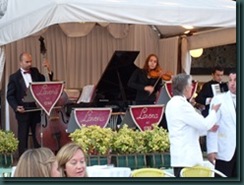 Same way, you can find shops of every kind of stuff: clothes, shoes, jewelry, souvenirs, cameras and photo supplies, etc..
Same way, you can find shops of every kind of stuff: clothes, shoes, jewelry, souvenirs, cameras and photo supplies, etc.. One thing they told me and that gets people thinking as it is the invasion of sea water in the Piazza San Marco. And it really happens. In the photo below, we can see the floor of the gallery surrounding the plaza filled with water. So that tourists can visit the basilica during the day on which the square is flooded, are placed wooden walkways. Very interesting.
From Brazil, we had intended to watch an orchestra of strings playing The Four Seasons by Antonio di Vivaldi. We had already found, in the Internet, a group that plays in a church called Chiesa di Santa Maria Formosa and we went to check.  On the first day, we saw pieces of Verdi, Pucini and others by two singers, a man and a woman. It was a very rewarding experience, so the acoustics of the church provided us moments of great pleasure. But the highlight was certainly the next day (yes we're back ...) when we saw five musicians playing Vivaldi: cello, three violins and a viola (that violin a bit bigger). Simply unmissable. We became delighted with one of the most inspired musical sequences of all ages in a place like that. If you have chance, do not miss!
On the first day, we saw pieces of Verdi, Pucini and others by two singers, a man and a woman. It was a very rewarding experience, so the acoustics of the church provided us moments of great pleasure. But the highlight was certainly the next day (yes we're back ...) when we saw five musicians playing Vivaldi: cello, three violins and a viola (that violin a bit bigger). Simply unmissable. We became delighted with one of the most inspired musical sequences of all ages in a place like that. If you have chance, do not miss!
When we left the presentation in the church, it passed 10:00pm and we walked through Piazza San Marco and, as it had rained, there was few people on the streets. In one of the cafes there were musicians playing "The Way You Look Tonight" and Fabiana and I danced romantically in the middle of the square.
After Venice we went to M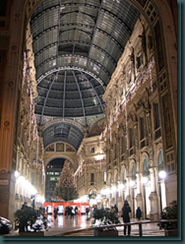 ilan to spend a night and come back to Brasil in the next day. As we arrived in the afternoon, we went for a downtoun walking and we had another surprise: it was happening the Milan Fashion Week in the Galleria Vittorio Emanuele II (photo), an impressive place with the most expensive griffes in the fashion world. Outside the gallery, it was going a rock concert and pop music in the Piazza del Duomo (as aways it had a Duomo).
ilan to spend a night and come back to Brasil in the next day. As we arrived in the afternoon, we went for a downtoun walking and we had another surprise: it was happening the Milan Fashion Week in the Galleria Vittorio Emanuele II (photo), an impressive place with the most expensive griffes in the fashion world. Outside the gallery, it was going a rock concert and pop music in the Piazza del Duomo (as aways it had a Duomo).
Well, that was our trip and I hope whoever is reading takes advantage of the experiences we had. If you have any questions or need any tips you did not find here, just write down and send to the email address eider.arantes.oliveira@gmail.com.
